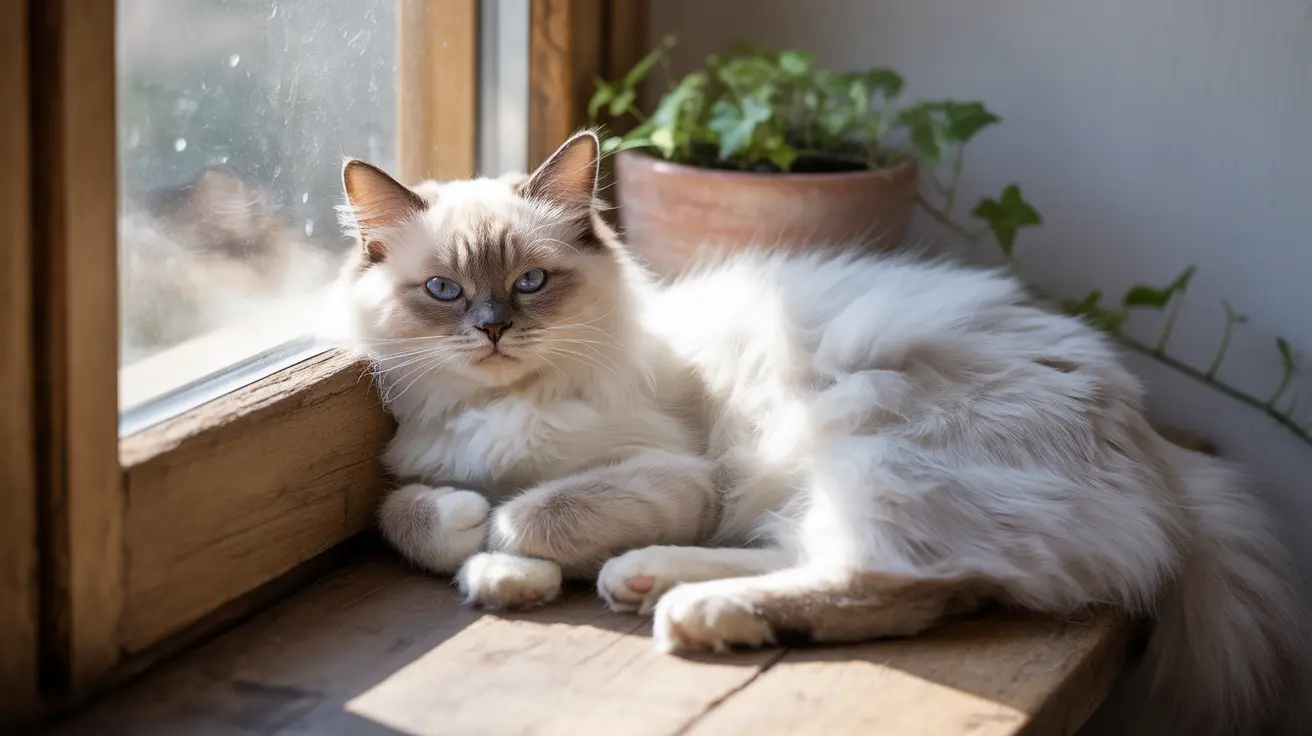Introduction
Cats are renowned for their remarkable sleeping habits, which have long fascinated both pet owners and animal behaviorists. While humans typically require around seven hours of sleep, cats dedicate an astounding 12 to 16 hours per day to rest. This significant difference in sleep duration stems from their evolutionary heritage as predators, where energy conservation became crucial for survival.
Understanding cat sleep patterns is essential for ensuring optimal feline health and well-being. These sleep habits are deeply rooted in their ancestral behaviors, directly impacting both their physical condition and behavioral wellness. From kittens to senior cats, each life stage brings unique sleep requirements and patterns that owners should recognize and accommodate.
This comprehensive guide explores the fascinating world of feline sleep, examining everything from sleep cycles and duration to health considerations and environmental factors that influence your cat's rest patterns.
The Science Behind Cat Sleep Cycles
Cats have evolved a unique sleep-wake pattern that differs significantly from humans. Their sleep occurs in multiple cycles throughout the day, with each cycle including both light and deep sleep phases. During these cycles, cats experience important stages of rest, including REM sleep, which is crucial for mental and physical recovery. This cyclical sleep allows cats to be immediately alert, aligning with their instincts as both predators and prey.
Sleep Patterns Across Life Stages
Different life stages demand varying amounts of sleep, which owners should consider in order to meet their cats' changing needs and promote healthy development at every age:
- Kittens require up to 20 hours of sleep daily for proper development. During this time, their bodies grow rapidly and their brains process copious new information, making abundant rest critical for building strong immune systems and healthy tissues.
- Adult cats typically sleep 12-16 hours per day. Their sleep helps preserve energy for bursts of activity and hunting, even if they are domesticated and do not hunt for food.
- Senior cats often need more rest, sometimes exceeding 18 hours daily. As felines age, their bodies require additional recovery time, and changes in metabolism or mobility can lead to increased sleep duration.
The Nature of Cat Naps
Unlike humans, cats don't follow a single long sleep period. Instead, they take multiple short naps throughout the day, typically lasting 15-30 minutes each. This "catnapping" behavior allows them to remain alert and ready for action while still getting adequate rest. Napping in shifts is an instinct retained from their wild ancestors, enabling them to quickly awaken and react to environmental changes or perceived threats.
Factors Influencing Sleep Duration
Breed-Specific Sleep Patterns
Sleep duration and patterns can vary greatly among different cat breeds. Some breeds are naturally more active, while others prefer a laid-back lifestyle:
- Persian and Ragdoll cats tend to be more relaxed and may sleep longer than average, often seeking out cozy spots to lounge for hours.
- Bengal and Abyssinian cats are typically more active and may sleep less, preferring to engage in play, exploration, or climbing throughout the day.
- Mixed-breed cats often display sleep behaviors that fall somewhere in between, influenced by their unique genetic background and personalities.
Understanding your cat's breed tendencies can help tailor their environment and daily routines to suit their natural inclinations.
Environmental Impact on Sleep
A cat's environment plays a crucial role in determining how long and how well they sleep. Several factors can affect both the quantity and quality of feline rest:
- Indoor cats may sleep more, as limited stimulation and fewer opportunities to expend energy can lead to extended periods of rest.
- Outdoor cats, by contrast, often maintain more active schedules. They may sleep less and experience shorter, more interrupted naps due to the demands of exploring and staying alert for potential threats.
- Temperature, lighting, and noise levels are also important factors. Cats tend to sleep more on cold or rainy days and may be disturbed by loud or unpredictable noises in their environments, impacting their sleep quality.
Providing a calm, climate-controlled, and well-lit space can help your cat experience improved and uninterrupted sleep, contributing to their comfort and overall health.
Signs of Healthy vs. Unhealthy Sleep
Normal Sleep Indicators
Healthy cat sleep patterns are characterized by several key indicators that signal proper rest and well-being:
- Regular and predictable sleep-wake cycles throughout the day
- Responsiveness to interaction and environmental stimuli during wake periods
- Normal energy levels, especially during their active times (typically dawn and dusk)
- Consistent and comfortable sleeping positions, often with occasional stretches or twitches during REM sleep
Observing these patterns can help reassure owners that their cat's sleep behaviors are within a normal and healthy range.
Warning Signs to Watch
Be alert for the following potential sleep-related issues, as they may be early indicators of underlying health problems:
- Excessive lethargy or difficulty waking, which could suggest illness or metabolic disturbances
- Unusual sleeping positions indicating discomfort, pain, or joint issues
- Dramatic changes in sleep duration—either much more or much less than usual
- Restlessness, agitation, or inability to settle and sleep soundly
If any of these signs are observed, it's important to consult a veterinarian to identify and address potential health concerns promptly.
Creating an Optimal Sleep Environment
To support healthy sleep patterns and ensure your cat gets the rest they need, consider the following tips:
- Provide multiple comfortable sleeping spots around the home. Cats love variety and may choose different locations throughout the day.
- Maintain consistent room temperatures, avoiding drafts and extreme heat or cold, to keep your cat cozy year-round.
- Create designated quiet zones away from high-traffic areas, allowing your cat to rest undisturbed when needed.
- Ensure access to natural light cycles by positioning beds near windows and minimizing artificial light at night. Natural light helps regulate a cat's internal clock and promotes a more consistent sleep-wake rhythm.
By optimizing these environmental factors, you create a peaceful, restful atmosphere that encourages longer and more restorative sleep for your feline friend.
Balancing Rest and Activity
While cats need plenty of sleep, it's equally important to provide them with mental and physical enrichment when they're awake. Maintaining proper sleep-wake cycles can help prevent boredom and reduce the risk of behavioral problems:
- Engage in regular play sessions to stimulate natural hunting behaviors and encourage physical exercise.
- Introduce environmental enrichment, such as scratching posts, climbing trees, or puzzle feeders, to keep your cat mentally active.
- Establish consistent feeding schedules to synchronize their routines and instill a sense of predictability.
- Use interactive toys and activities to promote curiosity and prevent your cat from becoming overstimulated or lethargic due to lack of engagement.
Balancing periods of rest with activity ensures your cat enjoys a fulfilling, healthy lifestyle.
Frequently Asked Questions
- Why do cats sleep so much? Cats sleep frequently due to their natural instincts and the need to conserve energy, a behavior inherited from their wild ancestors who needed to be prepared for hunting or evading danger at a moment's notice.
- How many hours a day do cats typically sleep? Most adult cats sleep between 12 and 16 hours per day, with some kittens and seniors sleeping even more.
- Do kittens and senior cats sleep more than adult cats? Yes, both kittens and senior cats require more sleep than healthy adult cats to support growth and recovery.
- Can a change in sleep patterns indicate health issues? Sudden changes or excessive sleep can signal underlying health problems and warrant a veterinary checkup.
- What factors influence how much a cat sleeps? Age, health status, activity levels, environment, and even breed traits all contribute to variations in sleep duration.
- How can I keep my cat active and engaged? Provide a variety of toys, set aside time for interactive play, and introduce climbing structures or puzzle feeders to stimulate your cat.
- What is REM sleep in cats? REM sleep is a deep sleep phase during which cats may twitch their paws or whiskers and are believed to dream—this stage is crucial for recovery and brain function.
- How does a cat's age affect its sleep needs? As cats age, their sleep requirements increase—kittens and seniors generally sleep much more than adult cats to support development or recuperate from age-related changes.
- Are certain sleeping positions a sign of health issues? While many positions are normal, strange or painful-looking postures may indicate discomfort or illness and should be monitored.
- When should I consult a vet about my cat's sleep? Veterinary advice is recommended if your cat exhibits extreme changes in sleep duration, unusual positions, or persistent lethargy.
- How can I create a healthy sleep environment for my cat? Offer a quiet, comfortable, and secure space with multiple cozy resting spots away from noise or disturbances.
Conclusion
Understanding and supporting your cat's sleep patterns is crucial for their overall health and happiness. By monitoring their rest habits and providing an enriching environment that balances activity with adequate sleep opportunities, you can help ensure your feline friend maintains optimal well-being throughout all life stages.






